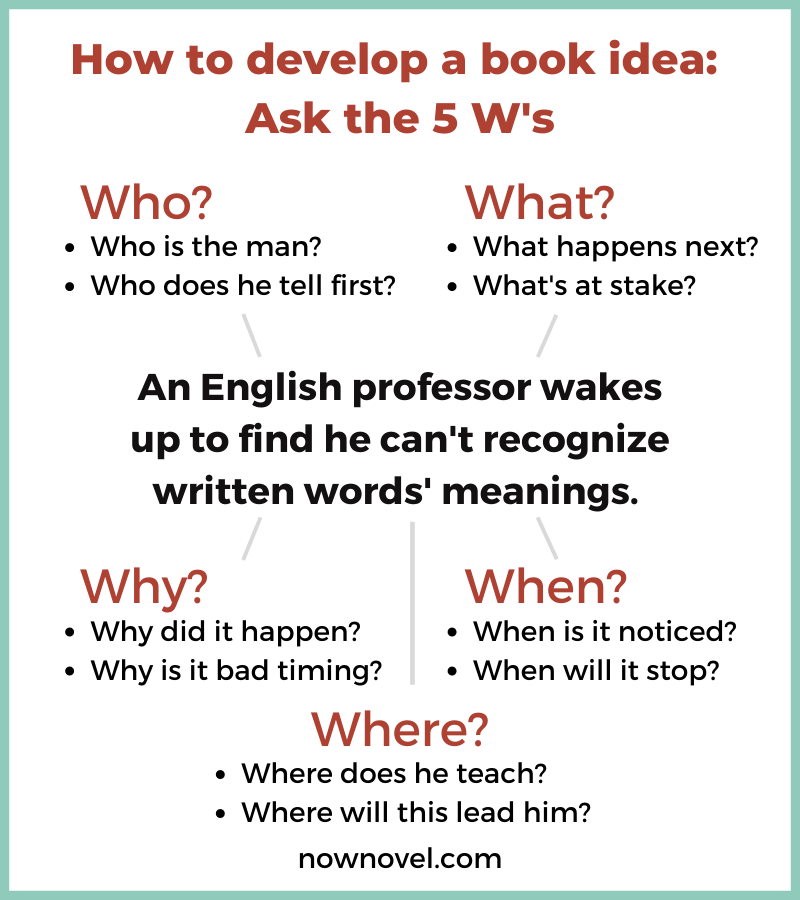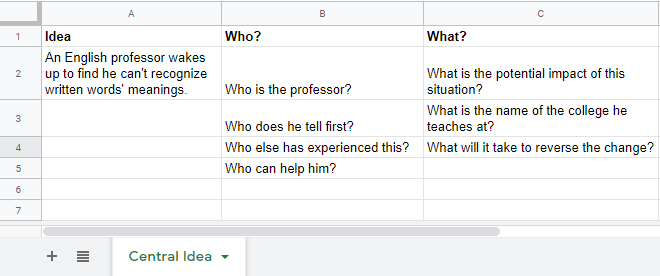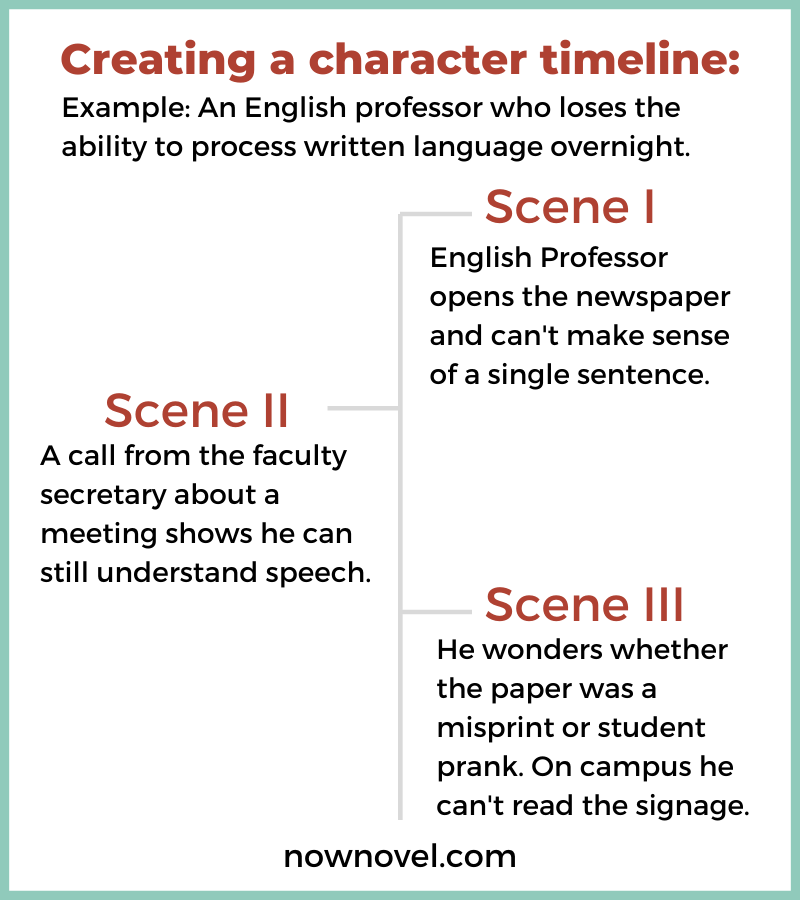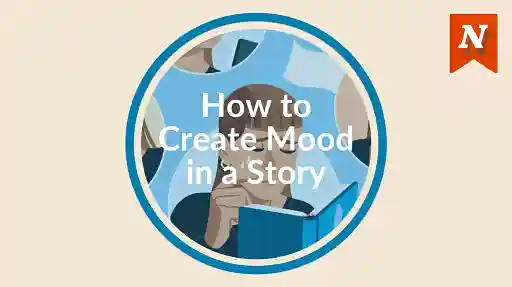So you've got a book idea. There's a story image or event teasing your imagination. How do you develop a book idea in a germinal state into something detailed, more ready to begin your draft?
Read 8 ways to build on a founding story idea:
1. Condense your book idea into a logline
This might sound strange advice. You're trying to grow your book idea, after all. Yet putting your central idea as a brief synopsis is helpful for beginning with clear focus, and just enough detail.
Read these loglines for famous authors' books. They convey a clear, focused idea of what the story is about:
Children with special talents are abducted and sequestered in an institution where the sinister staff seeks to extract their gifts through harsh methods.
Logline for Stephen King's The Institute (2019)
Two boys respond to horrors at a Jim Crow-era reform school in ways that impact them decades later.
Logline for Colson Whitehead's The Nickel Boys (2019)
Both of these story ideas gives a broad sense of multiple aspects of the story: Who it involves, where it's set, potential sources of narrative tension that require resolution (abductions, injustice), and so forth.
Try to summarize your own story idea in the present tense like this [you can also work through the easy step-by-step prompts in our story outlining tool to brainstorm your story idea.]
Once you have your logline:
2. Brainstorm who, what, why, where and when
The 5 w's of story are universal to stories across media: Novels, films, stage plays, narrative video games (such as RPGs).
In all stories, some details about who, what, why, where and when are given to us to begin. This we call 'exposition' - the part of a story introducing parameters that delimit the story's scope, such as places, situations and people.
Asking questions about the five w's, using your logline as a guide, is a valuable process in how to develop your book idea fast.
Let's take Stephen King's novel's premise as an example. Write this logline out (you can find others via Hawes' bestseller lists here).
Children with special talents are abducted and sequestered in an institution where the sinister staff seeks to extract
their gifts through harsh methods.
Start asking story development questions such as:
Who?
For example:
- Who is abducting the children?
- Who knows about the abductions?
- Who are the abducted children?
- Who are the institution's staff members?
- Who stands to benefit from these creepy goings on?
What?
'What?' questions you could ask to develop this book idea include:
- What are the children's special talents?
- What is driving the institution's practice (fear/greed/another motivation?)
- What happens to the children after extraction?
Why?
'Why' questions you could ask to develop your book idea include:
- Why is the institution intent on extracting the children's gifts?
- Why do the children have special talents?
- Why is each staff member going along with the system?
Where?
'Where' questions you could ask include:
- Where is the institution located?
- Where are the children kept within the institution?
- Where is the extraction process conducted?
- Where are the children's families through all of this?
When?
Lastly, ask 'when' questions such as:
- When is the story set?
- When are the children captured (what age)?
- When do the children learn why they've been abducted?
- When do people not part of the institution find out about it?
Each of these questions could spark an introduction to a setting, a scene, a character idea, and so forth.
You may also decide to create a mind map:
3. Create a mind map for your idea
Mind maps are useful for jotting down and roughing out book ideas.
Write your logline or central idea summary in the middle of a page.
Next, write the headings 'Who?', 'What'?', 'Why?', 'Where?' and 'When?' around it, with space enough beneath each to write.
Then ask some questions relating to your idea, like this:

If you use a large enough sheet of paper (A3 works well), you can have space to write possible answers for each of the questions you devise. Or use a free-form drawing tool in an image editing app such as MS Paint or Canva.
4. Develop your idea using Google Sheets
If you don't like the idea of mind-mapping by hand, you could use Google Sheets to explore and expand on your book idea.
The same exercise above you could do by having a column for each of the 5 w's:

As you can see, we've created a tab for 'Central Idea', but you could do the same exercise for scene ideas and characters, too, creating a tab for each idea.
5. Interview your characters
This is a fun exercise as it takes you further into imagining and filling in the blanks.
If you already have an idea for a character or two, imagine you're sitting down and interviewing them. Write a series of interview questions and imagine their answers.
For example, say you are interviewing a potential staff-member-character for the child-abducting institution in King's novel. You might write something like:
Q: Why did you first join the institution?
A: The children of today lack discipline and I approved of the rigorous rules of the facilities.
This example question and response might inspire you to create a staff member who is rule-bound and thinks in black and white, yet acts sadistically in pursuing 'discipline' above empathy and other important, humane values.
An exercise like this is useful as it helps you to bring your developing book idea out of the abstract. It helps you find concrete character ideas which in turn will fuel scene ideas (for example, a scene where a child captured by the institution first encounters this specific staff member).
6. Write a character's journal
Another way to delve deeper into your story idea's potential is to write a character's journal.
If you were Stephen King writing The Institute, for example, you could write a few pages from one of the children's perspectives. Try writing half a page, detailing everything that happens from the day of their abduction.
Applying this exercise to your own characters could help you better understand their hopes, fears, and the chain of events that makes up their character arc.
7. Create story timelines
Timelines are useful visual tools for brainstorming sequences of events or character developments from your initial idea.
Say, for example, you wanted to brainstorm the immediate aftermath of the discovery the professor makes in the mind-mapping example:

Simply the process of creating your timeline may jog ideas for scenes you never had before (like the image of the professor being bewildered by buildings' signs on campus)
8. Use a structured, step-by-step process
The problem with asking yourself questions is the process, while inspiring, may feel unstructured.
The step-by-step outlining process in our story dashboard is a structured exercise that takes you through first steps (finding your Central Idea) to developing and outlining characters, plot points and settings.
As you go, everything you write adds automatically to a private PDF you can download at any point from the dashboard and use as a guiding outline as you write your draft.
Try it now - and enjoy developing your story!









Hi folks, thanks for more good tips from NowNovel! My logline for Agent Raven: Trickster inspires an unwitting and worldly entrepreneur to attempt seizing control of global economies using quantum computing.
J Pierre33 - Over 5 years ago
Hi JP, Thanks for reading and sharing your logline, JP. Some immediate questions I'd ask (off the top of my head): What does this 'Trickster' do to inspire this attempt at world domination? Why is the 'world entrepreneur' character unwitting? (This seems to contradict the idea of their trying to control the global economy which sounds a very 'witting' (or rather, intentional) plan. I'd say keep asking questions of this order. Good luck!
Jordan At Now Novel - Over 5 years ago